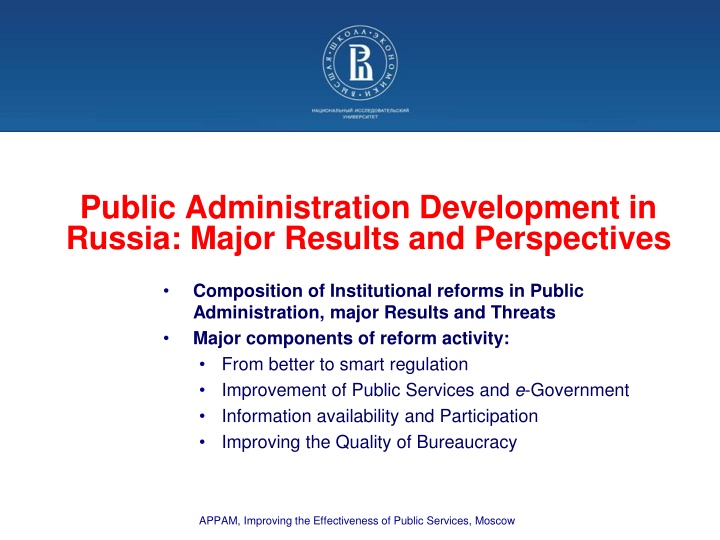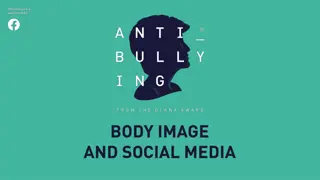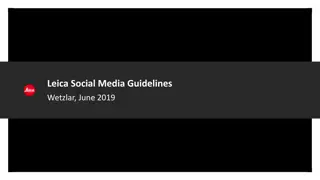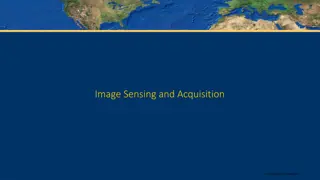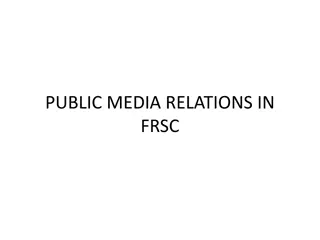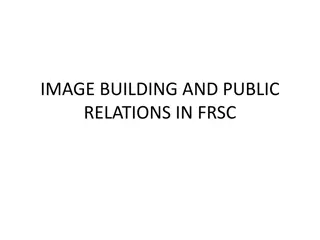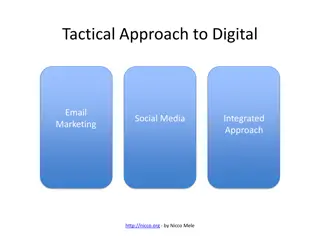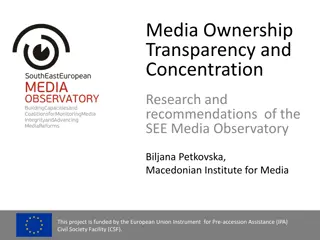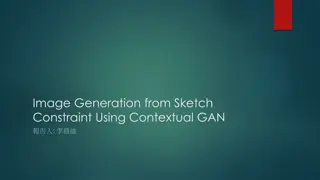Basics of Public Image Media Training
Learn how to effectively communicate your organization's message to various media outlets, including tips on news releases, event promotion, and interaction with the press. Discover key strategies for successful media engagement and public relations.
Download Presentation

Please find below an Image/Link to download the presentation.
The content on the website is provided AS IS for your information and personal use only. It may not be sold, licensed, or shared on other websites without obtaining consent from the author.If you encounter any issues during the download, it is possible that the publisher has removed the file from their server.
You are allowed to download the files provided on this website for personal or commercial use, subject to the condition that they are used lawfully. All files are the property of their respective owners.
The content on the website is provided AS IS for your information and personal use only. It may not be sold, licensed, or shared on other websites without obtaining consent from the author.
E N D
Presentation Transcript
Public Administration Development in Russia: Major Results and Perspectives Composition of Institutional reforms in Public Administration, major Results and Threats Major components of reform activity: From better to smart regulation Improvement of Public Services and e-Government Information availability and Participation Improving the Quality of Bureaucracy APPAM, Improving the Effectiveness of Public Services, Moscow
Composition of institutional reforms in Public Administration Public service reform (1) X Public service reform (2) Administrative reform (1) X Administrative reform (2) Performance Management and Budgeting Better regulation E-Russia X Information Society Program 2002 2004 2006 2008 2010 2012 2020 National anticorruption strategy Division of responsibilities between federal, regional and local levels of government 2
Comparative institutional advantages former USSR republics GRICS (2009) Country's Percentile Rank (0-100) RUSSIA KAZAKHSTAN BELARUS GEORGIA 45 35 24 12 48 39 35 19 13 9 19 23 62 70 50 52 Government Effectiveness Regulatory Quality Rule of Law Control of Corruption Doing business - rank in 183 (2011) Doing business - rank in 183 (2011) RUSSIA RUSSIA KAZAKHSTAN KAZAKHSTAN BELARUS BELARUS GEORGIA GEORGIA 123 108 93 18 18 123 108 93 59 47 44 36 36 59 47 44 68 7 109 12 12 68 7 109 12 8 20 41 41 12 8 20 Total Starting a Business Starting a Business Protecting Investors Protecting Investors Enforcing Contracts Enforcing Contracts 3
Key performance indicators of Administrative reform (2005 - 2010) Performance indicators 2004 Planned to 2010 Performed 14% 70% 18% (2008 .) Quality and equal access to Public services (% of respondents) 8,5% 3% 6% Administrative Burden on Business (% in total output) 48,1% 70% 44,9% (2009 .) GRICS: Government Effectiveness 30,5% 70% 35,2% (2009 .) GRICS: Regulatory Quality 4
Growth of Bureaucracy in the RF Number of executive bodies in Russian Empire, USSR and RF 2010 - 6876 functions 2010 77 2008 86 2006 85 2004 - 5634 functions 2004 80 2002 59 About 20% of the powers of the authorities have full-fledged regulatory support There is insufficient correlation of powers with the aims and objectives of national development 2000 58 1998 68 1996 78 1994 67 1992 69 1991 51 1900 15 0 20 40 60 80 100 Number of civil servants 000 people 900 800 700 600 500 400 Federal level Regional level Municipalities 300 200 100 0 2000 2001 2002 2003 2004 2005 2006 2007 2008 2009 5
Weaknesses and Threats - Priority Tasks Worsening of the institutional environment for business and the lives of the civilian population inconvenient conditions for doing business, high risks, insufficient protection of property rights and contract performance guarantees Worldwide loss of the nation s competitiveness A manual control regime, imitation of reforms, insufficient coordination of separate departments of Executive authority Lack of controllability within the executive power High administrative burden, failure to reach regulatory objectives, corruption and ineffective use of public resources Excessiveness and ineffectiveness of government regulation A predominance of traditional public service provision arrangements that are onerous for the applicant Low quality of public service No distinct and reliable link between citizens priorities and the objectives of government policy, a lack of desire to collaborate Lack of trust in authoritative institutions Lack of an effective contract between society and Negative selection , shortage of managerial capital in the executive authority system in line with the level of objectives faced bureaucracy New Agenda for 2011 2020 Effective regulatory and legal framework Qualitative and accessible public and municipal services Extensive reformation of the relationship between the state and the civil society 6
Key deficiencies of regulation Lack of clear and transparent criteria for and assessment procedures of unacceptable risks as a condition for government regulation and it s objectives Declarative nature of requirements and their lack of correlation with achievement of government regulation objectives (high discretion of public servant decision) Excessive forms of control (monitoring and supervision) of established mandatory requirements and their duplication Preventive nature of forms of government regulation, creation of administrative barriers to commencing business activity or for market entry for products Widespread intermediary services in the performance of control and supervision government functions Nonconformity of the subjects of government regulation, requirements and forms of control to international documents Chaotic nature of implementing and excluding measures of government regulation As a result: A drop in innovative and business activity Corruption and abuse of office by public servants Loss of competitive edge 7
The burden of government regulation The World Economic Forum - The Russia Competitiveness Report 2011 8
Percent of senior management time spent dealing with the government The World Economic Forum - The Russia Competitiveness Report 2011 9
The cost of building a road The World Economic Forum - The Russia Competitiveness Report 2011 10
Better regulation within existing forms Targeted orientation and evidentiary procedure exclusion of inadmissible risks, linked with harming public life and health and the environment, restricting competition and unequal access to limited resources. Establishing measures of regulation exclusively through legislative acts Integrity and complexity of regulation objectives, requirements, forms and methods are mutually connected; inadmissibility of a declarative nature of requirements and the exclusion of permissions and control if there are no distinct requirements Excluding excessiveness and duplication. Creating mechanisms that prevent the restoration of eradicated superfluous forms of regulation Minimising intermediary services admissible only if there is no corresponding technical basis in the public monitoring (supervisory) authority, no specialist knowledge and skills Outsourcing (to accredited bodies) of part of the conformity assessment functions by sites, where risks are moderate Switching from preventive forms of assessing conformity (monitoring) that restrict market entry to ongoing monitoring (supervision) with simultaneous consolidation of liability measures for breaches of stipulated requirements Introduction of predominantly term-free validity for permission documents and documents that confirm conformity Forming a monitoring system for effective government regulation and feedback on its results, determining the directions required for improving the system of regulation Harmonising sites, requirements and forms of regulation with international documents, allowing for national interests Facilitating voluntary entry into self-regulatory organisations (SRO) of entrepreneurs who operate in those fields where there is no inadmissible risk or whose security has already been facilitated through other methods of government regulation 11
On a Way to Smart Regulation Supplementing RIA with retrospective assessment procedures Performing regular and comprehensive analysis of current legislation and the regulatory framework Tracking the actual impact of normative-regulatory acts on the state of the regulatory sphere Allocation of RIA on all levels of authority Inclusion into the financial and economic feasibility assessment of draft laws as an obligatory component not only for assessing budget expenditure of different levels, but also costs and benefits of private organisations and civilians Introducing the practice of legal experiments ( sunset legislation), with articles on regular (tracking, expedited) assessment of a regulatory act s effectiveness Creation and further development of mechanisms for involving recipients of regulatory activity (businesses, not- for-profit organisations and civilians) in the planning of normative-regulatory acts (Internet panels, public evaluation, public consultation and so on) Switching to a law-making language that is easy for end users (recipients of regulatory activity) to understand Creation of a unified public information resource of RIA, to facilitate disclosure of draft normative-regulatory acts at the early stages of their elaboration Reflecting plans and programmes on the websites of public authorities, pursuant to which decisions of executive authority and draft acts are drawn up Setting up forums on the portals of public authorities in order to discuss draft decisions 12
Improvement of Public Services Defining objectives Describing procedures From 'as is' to 'to be' 1. ( , , , ) , , . . , . . 5. ( ) 3. ( ) 2. ( ) . . 1. 1. 1. 2. 2. 2. 3. 3. 3. 4. 4. 4. . . 1.1. 2.1. - 2.1. - 4.1. 4.1. 3.1. 3.1. . . 3.2. 3.2. 1.2. 2.2. 2.2. 4. ( ) 4.2. - 4.2. - , . - - . - , . . - , 2.3. 2.3. 1.3. 3.3. 3.3. 4.3 , 4.3 , . . 3.4. 3.4. . . 1.4. 4.4. 4.4. 6. - ( , , , ) 1.5. - - ( , , .) - User satisfaction Cost per unit fees Government goals achievement ? ? ? Administrative regulation as an act Implement in electronic form Administrative regulation - normative act, prescribing procedures for execution of functions and service delivery Standard a list of service requirements, provided by government agencies: Description of required outcomes, timing of service delivery, office conditions, required fee or charge for Service (if it is not free), requirements for information 13
, , - , , , ? , ( , ): , The Landscape of Quality of Public Services in Russia (assessed as good) , , ? . . . . . . . . . - . - . . . . - . . . . - . . - . - . . . . . . . - . . . . - . - . - . . - . . - . - . - . . . - . - . . . . . . . - . . - - . . . - . - . . . . . - . . - . . . - . , % . - . . . . . 12 16 19 . - . - . 12 14 19 - . 14 16 . - . - . . - Issue and replacement of Russian Federation passports and other identity documents (5 million passports a year, over recent years, with receipt of passports and registration by place of residence, corruption has fallen from 33% to 23%) . . O Registration at place of residence and place of stay (4.4 million applications, time spent by applicant decreased by 2 times) 14
Further measures on client orientation and reinforcing liability for service quality. E-services as a priority Organising the delivery of public and municipal services pertaining to practical situations joint elaboration of standards on the agreement of services of different departments and levels of authority Orienting service delivery technologies for different client groups, accounting for their preferences, and multichannel service provision Outsourcing service functions outside public service Creation of economic incentives for quality service delivery by using government assignments (when forming the corresponding market for services) Payment for service delivery allowing for quality (preferably a one-off and differentiated duty) Independent monitoring and quality control of service provision upon the delivery of public and municipal services; decision making pertaining to development of the service delivery system, based on quality control data Intergovernmental and interdepartmental workflow and information exchange Creating nationwide communication and identification database systems Optimizing the process chain and reducing the cost of bureaucracy Orienting legislation to IT capabilities 15
Unified portal of public services - combine both electronic resources and services by various departments at federal and regional levels
Access to information and participation The indication of comprehensiveness of information amounts to 33% and accessibility of information does not exceed 53% For the regions, comprehensiveness of information is rated as falling between 15% and 76%, while accessibility falls between 9% and 72% There is no clear list of information with restricted access Information is often unintelligible to the user Involvement of representatives from civilian society in the work of advisory commissions and working groups is often purely formal in nature Requirements pertaining to the format and the nature of accessible information, plus a friendly interface, allowing for separate user group queries Improving the system of public councils under the executive authorities, with obligatory inclusion of representatives from specialist non-profit organisations, establishing a list of departmental documents, on which the findings of the public council must be presented Improving the practice of the recruitment and employment of independent experts to work on the tender and certification committees and committees to regulate conflicts of interests 17
Public service administration and development of its human potential New HR technologies to recruit qualified personnel on the basis of competitive selection mechanisms are required. Recruitment and promotion in public service based on merits and achievements. Provision of a competitive basis for career development. Strategic Government HR management Remuneration system should be modified to provide more incentives for qualified personnel Compensatory package (social protection, opportunities for professional growth, moral incentives, etc.). should be consistent with the labor market conditions Personalisation of responsibility of public servants, allowing for the tasks facing the authority and the division in which it operates Professional schools and public management and administration programs should be updated to educate and train civil servants 18
Challenges and Risks Challenges Risks Weak consensus on the reform agenda Short implementation period Low level of leadership Insufficient coordination and poor planning of reforms Long-term political uncertainties for many reform areas Highly centralized decision making Risks of poor implementation and simulation of reforms Thank you 19
